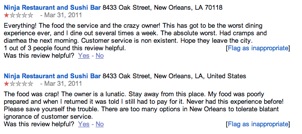Have You Been The Target Of A Google Places Hit Job?
It’s a Golden Grahams kind of day … You and your marketing team have set up the first steps to your local presence: a Google Places Page. Life is good. A few days later, you check in and you see that your position and display are great—but what is up with the three star rating? […]
It’s a Golden Grahams kind of day … You and your marketing team have set up the first steps to your local presence: a Google Places Page. Life is good. A few days later, you check in and you see that your position and display are great—but what is up with the three star rating?
Three stars isn’t so bad in any real-world rating, but online reviews tend to be rather extreme, so anything lower than 4 stars can be off-putting to the searcher.
As you start planning your reputation management strategy, you think that perhaps your staff had a bad day, so it’s just a matter of responding well to the bad review and mollifying the situation.
Then you start seeing bland, broad, confusing, or cross-promotional reviews. Paranoia sets in and the next thing you know, you’re muttering to yourself about being a victim of a “negative SEO” campaign by that competitor across the street. But is that really the case?
Check The Source
Checking the past reviews of those giving the bad press is your first step. Like with most low-quality reviewers, having only a few sparse reviews, especially purely negative ones, can be a sure spam signal.

Looking at past reviews will also show you the normal “editorial style” of the patron, allowing you to identify a perennial hater or a normally nice guy who had a truly wretched experience.
Either way, a business owner should exercise prudence in responding to reviews.
Answering a review with an uncertain source could muddle an issue that most readers would likely ignore as clearly spam anyway, and give the impression that the business doesn’t understand the marketing avenue they’re using.
Volume & Velocity
Two other factors can lead a business owner to a spammy conclusion – volume and velocity. The first is easy to see: if a reviewer has negatively reviewed your company multiple times, he’s either a glutton for punishment or actively trying to “downvote” your brand.
Two different reviews from the same person on the same day with somewhat different stories? Maybe the salmon mousse made the reviewer a little loopy, but that review history smacks of someone forgetting to log out between submissions or not realizing that the first try had gone through.

However, for a business owner, this kind of activity can show that sleep shouldn’t necessarily be lost over the customer’s experience.
Speed of reviews in a short period of time can point to a user trying to build clout for their profile without putting in a lot of effort. But 65 no-comment reviews in one day can show that the review your business received isn’t legitimate.
This review is positive for the restaurant, but taken into account with the other reviews on that day, the cause for praise is blunted.
To be fair, a regular user might be bored one day and quickly give all the places he’s been a star rating and nothing more – but is that kind of reviewer the one who’s going to warrant a meaningful response?
Is The Review For You?
Often, businesses with no relation to each other but similar names will get users or even Google Places confused. For example, I know for a fact that Ninja Restaurant and Sushi Bar in New Orleans unfortunately does not serve the wondrous Spam Local Moco.
Again, you have to turn to the reviewer page. A quick Google search shows that there is a Portland sushi bar with a similar name that serves that Hawaiian delicacy, and the reviewer talking about the dish is largely active in and around that city. A simple confusion on the reviewer’s part about the name of the place led him to one that was thousands of miles away.
Fortunately for this restaurant, his experience at the accidental sister sushi kitchen was positive, but a first-time patron of the restaurant wouldn’t be able to identify such a case of mistaken identity based on menu choice alone.
What You Can Do About Bad Reviews
The rules of review responses haven’t changed, and you can’t dismiss even a wave of bad reviews as just your competitors besmirching your good name. Most reviews, even ones that look like spam on the top level, are real people, and ought not be treated as a SEO trick unless you’re 100% sure.
Respond, help, and give your company a good name – even if it doesn’t change the minds of those who wrote the reviews, the visitor will likely be happy to see that your business is being proactive about its online presence. Being meaningful and helpful, even for those who might be confused or even intentionally smearing, will make sure even a low review score will win over potential drop-ins.
Opinions expressed in this article are those of the guest author and not necessarily Search Engine Land. Staff authors are listed here.
Related stories
New on Search Engine Land

